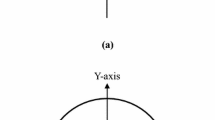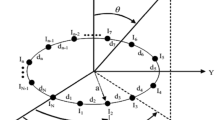Abstract
The genetic algorithm is used to synthesize the radiation pattern of the directional circular arc array to minimize the bit error rate (BER) performance in indoor wireless communication system. The impulse responses of the indoor channel for any transmitter-receiver location are computed by shooting and bouncing ray/image techniques. By using the impulse response of multipath channel, the performance of the synthesized antenna pattern on BPSK (binary phase shift keying) system with phase and timing recovery circuits can be calculated. Based on the topography of the antenna and the BER formula, the synthesis problem can be reformulated into an optimization problem and solved by the genetic algorithm. The novelty of our approach is choosing BER as the object function instead of sidelobe level of the antenna pattern, i.e., BER performance is defined as a object function to optimize the excitation coefficient of array by the genetic algorithm. The strong point of the genetic algorithm is that it can find out the solution even if the performance index cannot be formulated by simple equations. Besides, the genetic algorithm will converge to global extreme instead of local extreme and achieves a good antenna pattern. Numerical results show that the synthesized antenna pattern is effective to combat the multipath fading and can increase the transmission rate of indoor millimeter wave system.
Similar content being viewed by others
References
Manabe T., Miura Y., Ihara T., (1996). “Effects of Antenna Directivity and Polarization on Indoor Multipath Propagation Characteristics at 60 GHz”. IEEE Journal of Selected Areas Commununication 14, 441–448
Hammoudeh A.M., Allen G., (1995). “Millimetric Wavelengths Radiowave Propagation for Line-of-Sight Indoor Microcellular Mobile Communications”. IEEE Transactions on Vehicular Technology 44, 449–460
Bultitude R.J.C., Hahn R.F., Davies R.J., (1998). “Propagation Considerations for the Design of an Indoor Broad-band Communications System at EHF”. IEEE Transactions on Vehicular Technology 47, 235–245
Yang G., Pahlavan K., Holt T.J., (1994). “Sector Antenna and DFE Modems for High Speed Indoor Radio Communication”. IEEE Transactions on Vehicular Technology, 43, 925–933
M.R. Williamson, G.E. Athansasiadon, and A.R. Nix, “Investigating the Effects of Antenna Directivity on Wireless Indoor Communication at 60 GHz,” PIMRC 1997., The 8th IEEE International Symposium Vol. 2, pp. 635–639, 1997.
Goldgerg D.E., (1989). Genetic Algorithm in Search, Optimization and Machine Learning. Reading MA, Addision-Wesley
Rahmat-Samii Y., Michielsen E., (1999). Elextromagnetic Optimization by Genetic Algorithms. New York, Wiley
Ares F.J., Rodriguez A., Villanueva E., Rengarajan S.R., (1999). “Genetic Algorithms in the Design and Optimization of Antenna Array Patterns”. IEEE Transactions on Antennas and Propagatation 47, 506–510
Chuang J.C., (1987). “The Effects of Multipath Delay Spread on Timing Recovery”. IEEE Transactions on Vehicular Technology 35, 135–140
Greenstein L.J., Czekaj-Augmn B.A., (1982). “Performance Comparisons Among Digital Radio Technologies Subjected to Multipath Fading”. IEEE Transactions on Commununications 30, 1184–1197
Pahlavan K., (1985). “Comparison Between the Performance of QPSK, SQPSK, QPR, and SQPR Systems Over Microwave LOS Channels”. IEEE Transactions on Commununications 33, 291–296
Ares F., Rengarajan S.R., Lence J.A.F., Trastoy A., Moreno E., (1996). “Synthesis of Antenna Patterns of Circular Arc Arrays”. Electronics Letters 32, 1845–1846
Jiao Y.C., Wei W.Y., Huang L.W., Wu H.S., (1993). “A New Low-Side-Lobe Pattern Synthesis Technique for Conformal Arrays”. IEEE Transactions on Antenna Propagation 41, 824–831
Chen S.H., Jeng S.K., (1997). “An SBR/Image Approach for Radio Wave Propagation in Indoor Environments with Metallic Furniture”. IEEE Transactions on Antennas and Propagation 45, 98–106
K. Sato, T. Manabe, T. Ihara, H. Saito, S. Ito, T. Tanaka, K. Sugai, N. Ohmi, Y. Murakami, M. Shibayama, Y. Konishi, and T. Kimura, “Measurements of Reflection and Transmission Characteristics of Interior Structure of Office Building in the 60 GHz band,” Proceedings IEEE International Symposium on Personal, Indoor and Mobile Radio Communication, Vol. 1, pp. 14–18, 1996.
Author information
Authors and Affiliations
Corresponding author
Rights and permissions
About this article
Cite this article
Chen, CH., Chiu, CC. & Liu, CL. Novel Directional Radiation Pattern by Genetic Algorithms in Indoor Wireless Local Loop. Wireless Pers Commun 42, 575–586 (2007). https://doi.org/10.1007/s11277-006-9212-9
Received:
Accepted:
Published:
Issue Date:
DOI: https://doi.org/10.1007/s11277-006-9212-9




